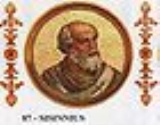
Pope Sisinnius
Encyclopedia
Pope Sisinnius was Pope
for about three weeks in 708.
A Syrian
by birth, Sisinnius's father's name was John. The paucity of donations to the papacy during his reign (42 pounds of gold and 310 pounds of silver, a fraction of the personal donations of other contemporary pontiffs) indicate that he was probably not from the aristocracy.
Sisinnius was selected as pope during the Byzantine Papacy
. He succeeded Pope John VII
after a sede vacante
of three months. He was consecrated around January 15, 708.
Sisinnius remained pope for twenty days. According to the Catholic Encyclopedia
, "although he was so afflicted with gout
that he was unable even to feed himself, he is nevertheless said to have been a man of strong character, and to have been able to take thought for the good of the city". Among his few acts as pope was the consecration of a bishop for Corsica
. He also ordered "that lime be burned in order to restore portions" of the walls of Rome. The restoration of the walls planned by Sisinnius was carried out by Pope Gregory II
. The book True Christianity: The Catholic Way credits him with defending the Church against the Lombards
and Saracens.
Sisinnius was buried in Old St. Peter's Basilica. He was succeeded less than two months later by Pope Constantine
. Constantine, also Syrian by birth, was probably the brother of Sisinnius.
Pope
The Pope is the Bishop of Rome, a position that makes him the leader of the worldwide Catholic Church . In the Catholic Church, the Pope is regarded as the successor of Saint Peter, the Apostle...
for about three weeks in 708.
A Syrian
Syriacs
Syriac may refer to:* Syriac alphabet* Syriac language* Syriac Christians* Syriac Christianity, the churches using Syriac as their liturgical language* Assyrian/Chaldean/Syriac people, adherents of Syriac Christianity-See also:...
by birth, Sisinnius's father's name was John. The paucity of donations to the papacy during his reign (42 pounds of gold and 310 pounds of silver, a fraction of the personal donations of other contemporary pontiffs) indicate that he was probably not from the aristocracy.
Sisinnius was selected as pope during the Byzantine Papacy
Byzantine Papacy
The Byzantine Papacy was a period of Byzantine domination of the papacy from 537 to 752, when popes required the approval of the Byzantine Emperor for episcopal consecration, and many popes were chosen from the apocrisiarii or the inhabitants of Byzantine Greece, Byzantine Syria, or Byzantine Sicily...
. He succeeded Pope John VII
Pope John VII
Pope John VII was pope from 705 to 707. The successor of John VI, he was of Greek ancestry. He is one of the popes of the Byzantine captivity.-Biography:...
after a sede vacante
Sede vacante
Sede vacante is an expression, used in the Canon Law of the Catholic Church, that refers to the vacancy of the episcopal see of a particular church...
of three months. He was consecrated around January 15, 708.
Sisinnius remained pope for twenty days. According to the Catholic Encyclopedia
Catholic Encyclopedia
The Catholic Encyclopedia, also referred to as the Old Catholic Encyclopedia and the Original Catholic Encyclopedia, is an English-language encyclopedia published in the United States. The first volume appeared in March 1907 and the last three volumes appeared in 1912, followed by a master index...
, "although he was so afflicted with gout
Gout
Gout is a medical condition usually characterized by recurrent attacks of acute inflammatory arthritis—a red, tender, hot, swollen joint. The metatarsal-phalangeal joint at the base of the big toe is the most commonly affected . However, it may also present as tophi, kidney stones, or urate...
that he was unable even to feed himself, he is nevertheless said to have been a man of strong character, and to have been able to take thought for the good of the city". Among his few acts as pope was the consecration of a bishop for Corsica
Corsica
Corsica is an island in the Mediterranean Sea. It is located west of Italy, southeast of the French mainland, and north of the island of Sardinia....
. He also ordered "that lime be burned in order to restore portions" of the walls of Rome. The restoration of the walls planned by Sisinnius was carried out by Pope Gregory II
Pope Gregory II
Pope Saint Gregory II was pope from May 19, 715 to his death on February 11, 731, succeeding Pope Constantine. Having, it is said, bought off the Lombards for thirty pounds of gold, Charles Martel having refused his call for aid, he used the tranquillity thus obtained for vigorous missionary...
. The book True Christianity: The Catholic Way credits him with defending the Church against the Lombards
Lombards
The Lombards , also referred to as Longobards, were a Germanic tribe of Scandinavian origin, who from 568 to 774 ruled a Kingdom in Italy...
and Saracens.
Sisinnius was buried in Old St. Peter's Basilica. He was succeeded less than two months later by Pope Constantine
Pope Constantine
Pope Constantine was pope from 708 to 715. With the exception of Antipope Constantine, he was the only pope to take such a "quintessentially" Eastern name of an emperor...
. Constantine, also Syrian by birth, was probably the brother of Sisinnius.

